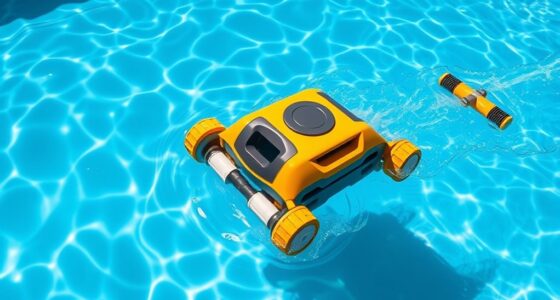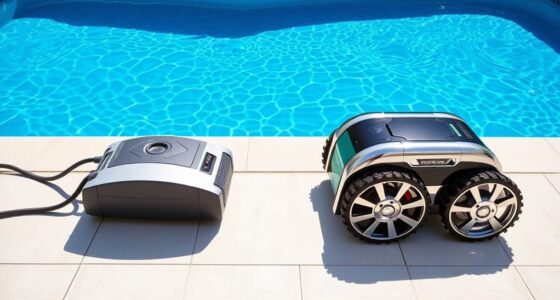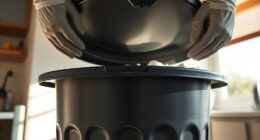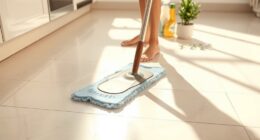To eliminate algae from your pool, it is essential to regularly check pH and chlorine levels within the range of 7.2-7.6 and 1-3 ppm respectively. Make sure to scrub the pool walls and vacuum any debris to prevent accumulation. Use appropriate algaecides and shock treatments as needed. Clean the filters every 1-3 months. Develop a maintenance routine that includes water chemistry tests, filter cleaning, pool brushing, and shocking. Prevent algae by adjusting chlorine levels, cleaning filters, using algaecide, maintaining good circulation, and balancing pH levels. Treat different types of algae with the appropriate methods. For saltwater pools, maintain a balance of chemicals, scrub, shock, and vacuum regularly. Success in removing algae depends on following these steps.
Key Takeaways
- Test water for pH and chlorine levels regularly.
- Scrub and vacuum pool surfaces to remove algae.
- Use algaecides and shock treatments as needed.
- Clean and maintain pool filters for efficient algae removal.
- Establish a routine maintenance schedule to prevent algae growth.
Types of Pool Algae
When dealing with pool maintenance, identifying the types of pool algae present is essential for effective treatment. Green algae is the most common and appears as a greenish tint on pool surfaces.
Mustard algae, also known as yellow algae, is chlorine-resistant and typically grows in shaded areas.
Black algae is tough to eliminate, forming dark, hard-to-remove patches on pool surfaces.
Pink algae, or pink slime, is actually airborne bacteria rather than a true algae species.
Each type of algae requires specific treatment methods for removal and prevention in pools.
Green algae can be treated by shock chlorination and brushing, while mustard algae may need a more aggressive approach involving algaecides specifically designed for chlorine-resistant strains.
Black algae removal can be challenging, often requiring scrubbing and using specialized treatments.
Pink algae prevention involves maintaining proper water circulation and sanitation to deter its growth on pool surfaces.
Testing Water Ph and Chlorine Levels
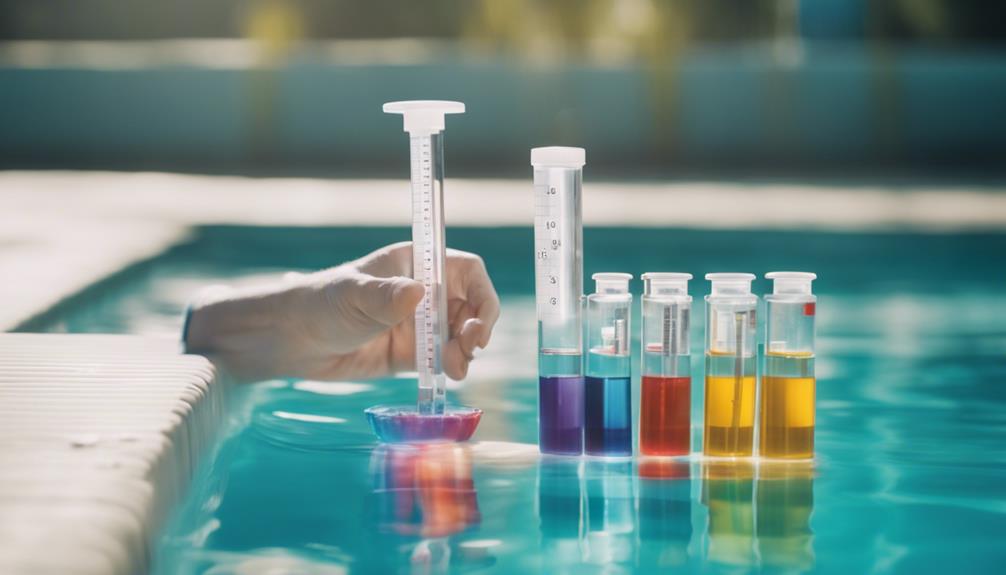
How important is it to regularly test your pool water pH and chlorine levels for effective algae prevention and removal?
To guarantee your pool stays clean and free of algae, it's vital to use a test kit to monitor the pH levels. The ideal range for pH is between 7.2 to 7.6.
Additionally, checking the chlorine levels using a pool test kit is essential. Chlorine levels should ideally be maintained at 1-3 parts per million (ppm) to effectively kill algae. Proper pH and chlorine levels create an environment where algae can't thrive, making it easier to prevent algae growth and maintain a clean pool.
Regular water testing helps in maintaining the proper chemical balance necessary for efficient algae removal. By monitoring pH and chlorine levels consistently, you're taking proactive steps towards keeping your pool algae-free and ensuring a sparkling clean swimming environment.
Manual Scrubbing and Vacuuming
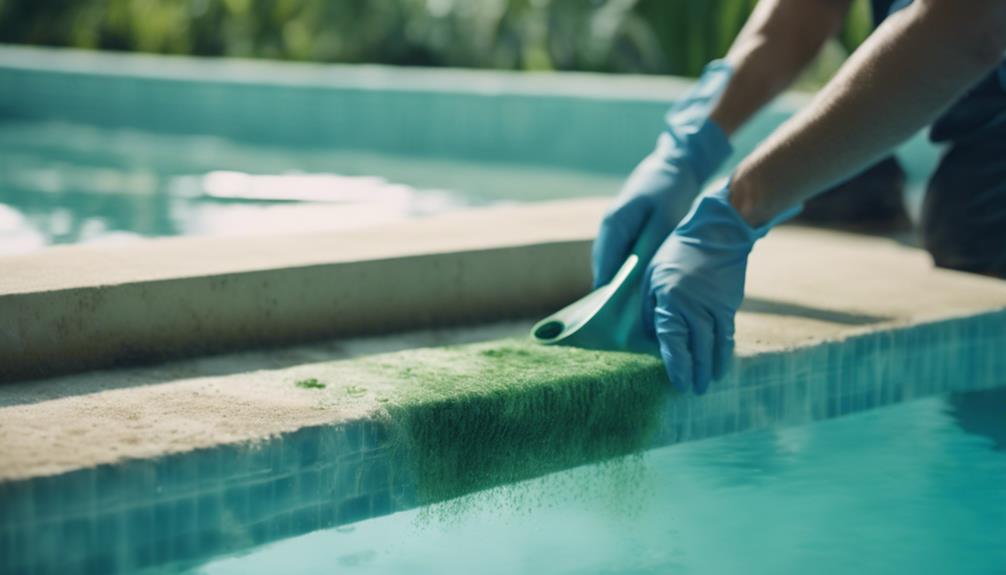
To effectively remove algae from your pool, start by manually scrubbing the pool walls using a stiff brush. This action helps eliminate algae buildup and prepares the surface for further cleaning.
Once scrubbing is complete, vacuuming algae debris from the pool floor guarantees a thorough cleaning and prevents further growth.
Scrubbing Pool Walls
For effective removal of algae from your pool, start by manually scrubbing the walls using a stiff brush and following up with vacuuming to guarantee thorough cleaning. Manual scrubbing involves physically removing algae from the pool walls and surfaces. It's important to scrub and vacuum to make sure all loosened algae debris is eliminated.
Regular scrubbing and vacuuming play an essential role in preventing algae buildup. Remember, proper technique is key for effective algae removal. Consistency in manual scrubbing and vacuuming is necessary for maintaining a clean pool free from algae. By incorporating these steps into your pool maintenance routine, you can effectively tackle algae issues and keep your pool sparkling clean.
Make sure to pay special attention to corners and crevices where algae tend to hide, and always follow a systematic approach to ensure no spot is left untouched.
Vacuuming Algae Debris
Start by making sure that you properly vacuum algae debris after manual scrubbing to thoroughly clean your pool surfaces and prevent regrowth.
Vacuuming is essential for eliminating dead algae particles and preventing the spread of algae spores.
Here are some tips to help you effectively clean your pool:
- Use a vacuum specifically designed for pool cleaning to efficiently remove algae debris.
- Move the vacuum slowly over the infested areas to ensure thorough cleaning.
- Pay extra attention to corners and crevices where algae tend to hide.
- Empty the vacuum filter regularly to maintain strong suction power and prevent debris from re-entering the pool.
Algaecides and Shock Treatments
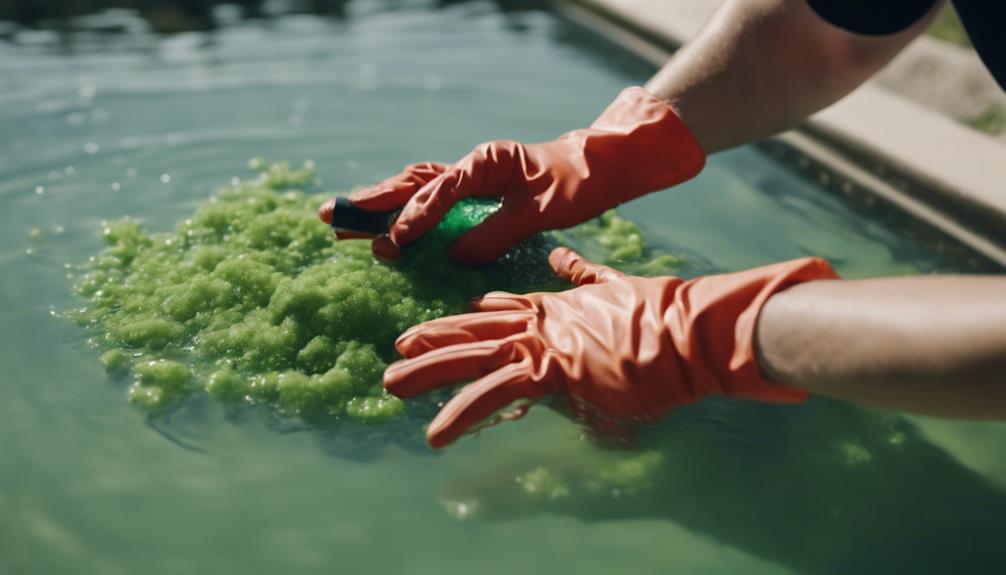
When dealing with algae in your pool, algaecides and shock treatments are your go-to solutions.
Algaecides target and destroy algae, while shock treatments swiftly eliminate contaminants.
Algaecides Types
Explore the various types of algaecides and shock treatments to effectively combat algae in your pool. When dealing with algae, different types of algaecides can come to your rescue:
- Copper-based: Utilizes copper to kill algae and prevent regrowth.
- Quaternary ammonia-based: Effective at eradicating algae and preventing its return.
- Polyquat-based: Works well for preventing algae buildup in your pool.
- High doses of chlorine: Shock treatments deliver a powerful punch to eliminate algae swiftly.
Algaecides act as a shield against algae, while shock treatments are the warriors that fight against existing algae.
Remember, always adhere to the manufacturer's instructions when using these products. This guarantees their effectiveness and keeps your pool safe for a invigorating swim.
Shock Treatment Benefits
Enhance the effectiveness of your algaecides by understanding the key benefits of shock treatments for combating algae in your pool. Shock treatments are essential for killing algae as they increase chlorine levels in the pool water, aiding in the elimination of algae when used alongside algaecides. These treatments also work to break down organic contaminants, enhancing water clarity. By regularly applying shock treatments, you can prevent algae growth and maintain a clean pool environment. Check the table below to see the impact of shock treatments on your pool:
| Benefits of Shock Treatments | |
|---|---|
| Kills algae effectively | Increases chlorine levels |
| Removes organic contaminants | Improves water clarity |
| Prevents algae growth | Maintains a clean pool |
Application Instructions
For best results when applying algaecides and shock treatments to your pool, carefully adhere to the manufacturer's dosage and application instructions. To guarantee effectiveness, follow these essential steps:
- Follow manufacturer's instructions: Always read and follow the guidelines provided on the algaecide and shock treatment labels to determine the right amount to use.
- Maintain proper pool pH level: Algaecides work best when the pool pH is between 7.2 and 7.6, so test and adjust the pH if needed before application.
- Wait 24 hours between treatments: After applying shock treatment, wait a full day before adding algaecide to prevent any potential chemical reactions.
- Brush and scrub pool surfaces: To thoroughly distribute the chemicals and remove algae, brush and scrub the pool walls and floor after applying algaecides and shock treatments.
Following these steps diligently will assist in effectively combating algae and maintaining a clean pool environment.
Cleaning and Maintaining Pool Filters
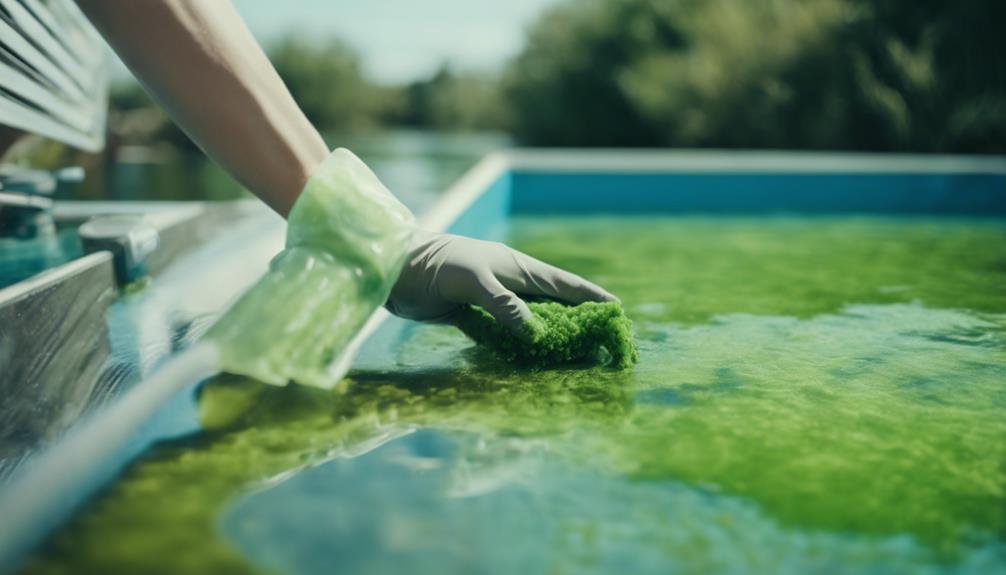
To maintain your pool water clean and free of algae, make sure you regularly clean and maintain your pool filters every 1-3 months. Dirty filters can lead to algae growth, so cleaning is essential for peak performance. Backwashing or replacing filters as needed helps remove debris and algae, ensuring efficient circulation and filtration. Proper maintenance of filters is vital for capturing and eliminating algae particles, reducing the risk of algae buildup.
| Pool Filters | Importance |
|---|---|
| Cleaning | Essential for preventing algae growth |
| Backwashing | Removes debris and maintains efficiency |
| Maintenance | Ensures top filter performance |
Regularly tending to your pool filters is a key step in keeping your pool water clear and algae-free. By following a routine maintenance schedule and cleaning your filters as needed, you can enjoy a sparkling clean pool all season long.
Establishing Routine Maintenance Schedule

Maintain an algae-free pool by establishing a routine maintenance schedule that includes testing water chemistry, cleaning the filtration system, and brushing pool surfaces weekly.
To keep your pool water clear and free of algae, follow these simple steps:
- Test the Water Chemistry: Regularly check the water to make sure it's properly balanced. Imbalanced water can create a breeding ground for algae.
- Clean the Filtration System: Ensure the pool filtration system is clean and functioning correctly. A well-maintained filter helps rid the water of debris that algae feed on.
- Brush Pool Surfaces: Weekly brushing helps remove algae spores from pool walls and floors, preventing them from growing and turning your pool green or black.
- Shock the Pool: Regularly shock the pool to maintain adequate chlorine levels and eliminate any potential algae growth.
Preventing Algae Growth

Regularly monitor and adjust your chlorine levels to effectively prevent algae growth in your pool. Proper chlorine levels act as a defense against algae infestation.
Additionally, make sure to regularly clean your pool filters to efficiently remove algae spores. Using algaecide weekly serves as a preventative measure to discourage algae buildup.
Good water circulation is key in preventing algae growth, as stagnant water can provide a breeding ground for algae. Test and balance pH levels to create an environment that's less conducive to algae growth.
By incorporating these practices into your pool maintenance routine, you can greatly reduce the likelihood of algae taking hold in your pool.
Treating Different Algae Types

When faced with different types of algae in your pool, understanding the specific treatment methods for each is essential for effective maintenance. Proper identification of algae type is vital for successful treatment and prevention strategies.
Here are some tips for treating different algae types:
- Green algae: The most common type can be tackled with pool shock and algaecide treatment.
- Mustard algae: Resistant to chlorine, it requires a boost in residual chlorine levels, vigorous scrubbing, and specialized algaecide treatment.
- Black algae: Tough to eliminate, it needs scrubbing with a pumice stone or brush, vacuuming, and specific black algae treatment products.
- Pink algae: Despite its name, it's airborne bacteria and can be managed with pink algaecide following a different process than for green algae.
Saltwater Pool Algae Treatment

For effective treatment of algae in your saltwater pool, focus on testing and rebalancing water chemistry. Algae can still thrive in saltwater pools due to factors like poor circulation, warm temperatures, and sunlight exposure. Here's a simple guide to help you tackle algae in your saltwater pool:
| Saltwater Pool Algae Treatment | Steps |
|---|---|
| Test and Rebalance Water Chemistry | Check and adjust pH and chlorine levels to create an inhospitable environment for algae. |
| Scrub Pool Surfaces | Use a brush to scrub off algae clinging to the pool walls and floor. |
| Shock the Pool | Add a high dose of chlorine to kill off algae and other contaminants. |
| Vacuum Pool Surfaces | Thoroughly vacuum the pool to remove dead algae and prevent regrowth. |
Frequently Asked Questions
How Do I Get Rid of Algae in My Pool Fast?
To get rid of algae in your pool fast, shock it with chlorine, brush and vacuum surfaces, and use algaecide. Maintain water balance and filtration. Consider hiring pros for quick removal. Keep your pool crystal clear!
What Kills Algae in a Pool Shock or Chlorine?
In the battle against algae in your pool, remember: shock is the hero that swiftly wipes out algae, while chlorine plays the essential role of keeping those green invaders at bay.
What Breaks Down Algae in Pool?
Chlorine, specifically free chlorine, disrupts algae cellular structure and inhibits growth. Algaecides target and kill algae. Enzymes digest organic matter algae feed on. Proper filtration and circulation help distribute chlorine and algaecides effectively to combat algae.
How to Clear up a Green Pool Fast?
Got a green pool emergency? Test water levels first. Shock it right with pool shock, then scrub like crazy to rid algae. Add algaecide, circulate water, and brush again. Voilà, a clear pool fast!
What’s the Best Way to Keep an Above Ground Pool Algae-Free?
The best way to keep an above ground pool algae-free is to maintain proper chlorine levels, regularly brush the walls and floor, and use a quality algaecide. Additionally, investing in a good pool filter and regularly cleaning it can also help. Following these tips and tricks for sparkling water will keep your pool looking pristine all summer long.
Conclusion
To sum up, keeping algae out of your pool requires regular maintenance and attention to water quality. By testing and adjusting pH and chlorine levels, scrubbing and vacuuming regularly, using algaecides and shock treatments when necessary, and cleaning and maintaining your pool filters, you can prevent algae growth and keep your pool clean and clear.
Remember, a little effort now can save you a lot of trouble later on. Keep your pool algae-free and enjoy a sparkling swimming experience!



